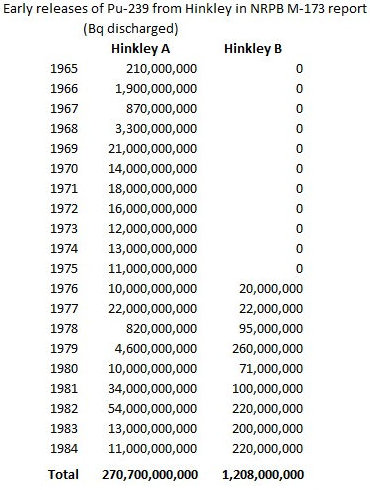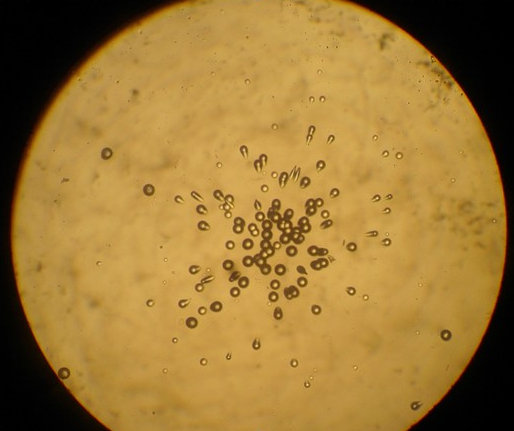Radiation and Hinkley – the background to why and how
The UK and the USA based nuclear arms club
After WWII, Britain was determined to stay in the nuclear arms race. To do this required the UK to supply the USA with military-grade plutonium. In 1956-7 Harold MacMillan kept strong pressure on Windscale to produce more Pu-239, though this over-stressed the reactor piles. This led to a serious fire in the core during October 1957 and the worst accidental discharge of radionuclides ever experienced in the UK. After that the two piles were closed down and the plutonium was required to be produced by new Magnox nuclear reactors being built, including new ones originally intended for civilian use to generate electricity.

Construction of Hinkley A nuclear power station had begun earlier in 1957. It was claimed to be only for generating civilian electricity. However, following the Windscale fire, by June 1958 the design had already been modified to be able to produce of high-grade military 239Pu for atomic weapons. This is recorded in Hansard in June 1958. There was also a letter about the production of plutonium in civilian nuclear power stations published in Nature in 2000.
After some early setbacks, the Hinkley A nuclear power station finally became operational in 1965. Hinkley B opened in 1976. Almost from the start, Hinkley A leaked over 30 different radionuclides and Hinkley B a similar number.
The NRPB M-173 document
A 1989 UK National Radiological Protection Board (NRPB) Memorandum M-173, produced as part of the Commission of the European Communities (CEC) MARINA Project, reported the levels known to have been discharged into the Severn (permitted and accidental) from 1965-1984 (see Tables 34 & 35 on document pages 83-87).
The Environment Agency stated to the NRA expert group (the Davidson Committee) that they had no knowledge of Plutonium being discharged from Hinkley and apparently they did not have a copy of NRPB M-173.
M-173 lists 34 different radionuclides discharged from Hinkley A and B, including 270,700,000,000 Becquerels (Bq) of Plutonium-239 from Hinkley A and 1,208,000,000 from Hinkley B by the end of 1984. We know that more was released after that, including during decommissioning due to damaged and disintegrating fuel rods in the cooling ponds. 239Pu has a half-life of 24,110 years (it loses half of its current radioactivity over this period). 239Pu emits high energy alpha particles (5.1 MeV) to become uranium 235U, another alpha-emitter.
Even these 239Pu (only) particle releases (and there were many other radionuclides released) already acknowledged up to 1984 could cause about a quarter of a million cancers in people according to Inhaled 239Pu Mortality.What happens to these hot particles?
Over time these hot radionuclide particles have settled into the mud and silt of the estuary. As long as they are not disturbed, they are relatively safe there. However, dredging this mud and silt and then dumping it in the estuary re-suspends the mud and radioactive particles in the sea-water from where they reach the air (in sea-spray) and wind-blown dust from the mud-flats where these fine particles tend to get left, close to high-tide levels.
Plutonium in the environment from a Magnox power station exists in oxide form as PuO2. These particles are generally smaller that 5 µm, and now are usually in the order of 1 µm (.001 mm). Over time the recoil energy from the alpha particle emissions tends to break up the particles into smaller and smaller pieces. As an alpha emitter, PuO2 is not particularly dangerous as an external radiation source, but if it is ingested or inhaled as dust or in sea-spray it is very dangerous and carcinogenic. It has been estimated that a pound (454 grams) of plutonium inhaled as plutonium oxide dust could give cancer to two million people.[1]

This image shows the impact of alpha particles from radioactive atoms in a random sample of dust from an air filter from a car on the Welsh coast close to Cardiff. Each of the marks show the damage done to the CR-39 plastic by an alpha particle emitted when a single uranium, plutonium or americium atom decayed.
In the case of the 273x109 Bq that is listed as being put into the estuary by Hinkley A and B by 1984, that is somewhere in the order of 100,000,000,000 tiny (0.1 µm) hot radioactive particles of PuO2 that are each giving off 2 alpha particles every second. These had settled in the mud and silt, mostly around the Hinkley site and around the Parrett estuary mud flats. Once these are dredged and re-dumped in the water, the fine particles are re-suspended in the sea water and get into aerosol form via sea-spray and also washed up and deposited on the beaches by high-tides. When this dries the dust can become air-borne and able to be inhaled. Hot plutonium particles have been found in an air-filter from a vehicle on the Cardiff coast.
This means that all dredged matter is not the same. Cefas admit this in their subsequent analysis that is reported in 'TR534 Radiological Assessment of Dredging Application for Hinkley Point C (2020). Part 2 – evaluation including radioanalysis of alpha/beta radionuclides' TR-534. This shows that they found significant levels of 239Pu in the top 0.5 metre of the three core samples that they did this extra analysis of (OS21 at intake site, OS01 and OF-B at outfall site). However, then they averaged the value with six samples taken from depths of 1 to 5.6 metres depth that contained virtually no 239Pu and then used that average value for their overall assessment. These were at mid-channel and not close to the actual Hinkley site (e.g. the dock area) where we would expect higher levels. The flawed Cefas testing methods are discussed on other pages of this website.
Next page: Hot Particles and radiological assessments.
